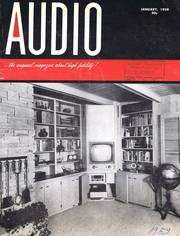Erläuterungen zu diesen US-AUDIO Seiten der 1950er Jahre
Die hier stehenden amerikanischen Artikel aus 1959 (aus der US-AUDIO) sind teilweise sehr gewöhnungsbedürftig, weil sie erstens aus einer längst vergangenen Zeit stammen und zweitens, weil dort in den USA ganz "anders" gedacht wurde als bei uns in Old Germany oder in Europa.
Vergleichbar mit unseren deutschen Hifi-Magazinen etwa ab 1962 ist jedoch, daß auch dieses Audio-Magazin ihre Anzeigen- Kunden und -Leser am Markt oder von anderen Magazinen (be- oder ab- ?) werben mußte. - Weiterhin sind die riesigen Dimensionen des amerikanischen Kontinents mit unseren hier in Europa nicht vergleichbar. - Ein Redaktions-"Trip" von New York nach Los Angeles oder Chicago oder gar in die Wüste nach Las-Vegas zu einer der CES- Audio- "Shows" war - auch mit dem Flugzeug - immer noch eine halbe Weltreise. Und jede Ausstellung oder "Messe" wurde als "Show" deklariert. Und natürlich, in USA musste alles "Show" sein, um beim Publikum einige Aufmerksamkeit zu erzeugen.
.
Die monatliche Kolumne - Editors' REVIEW - das Editorial
"THE OUTLOOK FOR TAPE" (Oktober 1959)
An interesting letter from movie old-timer Ernest B. Schoedsack appears in the Letters column on page 6 of this issue. He accuses (unterstellt) Audio - and other magazines as well - of conducting a campaign to discourage (abhalten) all interest in tape, tape recording, recorded tape, and everything pertaining to tape reproduction.
Since this wasn't a form letter, we can only believe that Mr. Schoedsack has not followed our columns closely over the past few months. Our Tape Guide section - started only last May 1959 - is well received, and is devoted entirely to tape.
To the charges that we have failed to review stereo tapes regularly we must admit we are guilty. On the other hand, Mr. S. will have to admit that with the introduction of the stereo disc there was a considerable reduction of interest in tape, since stereo tape was so much more costly than the newer and - let us admit it - easier-to-handle disc.
Ein gutes Magnetband ist besser als die Stereo LP
However, a step forward in one field may inaugurate new developments in another in order for them to keep in step. Granted that 7 1/2 ips tape is better than discs when played on a good machine - and we believe everyone will agree to that - few people are going to pay two or three times as much for tape as for discs, even though they all know that tape is better.
Bespielte Bänder sind einfach zu teuer
We do think that the recorded tape people did us an injustice in their pricing. Full 1.200-foot reels of tape recorded monophonically on two tracks were put on the market at an average cost of about $7.95, with a playing time of one hour.
The same 1.200 feet of tape could provide only one-half hour of playing time with two-track stereo, and while we realize that there is more trouble in making the original recording and possibly in the duplicating process, we do not believe that a stereo tape 1.200 feet long should cost around $14.95.
Instead of a two-to-one price difference for stereo over mono, we were faced with almost four times the price, based on the playing time. For this reason, we believe that the recorded tape manufacturers priced themselves out of the market and that they have only themselves to blame for the slump that was caused.
Now, of course, the tape people have come up with the four-track machines, and anyone who has heard one of the later models at 7 1/2 ips will agree that the quality compares with even the more recent 7 1/2-ips two-track machines, and easily with older machines at 15 ips.
If it is low price that the public wants - and we do not believe that price is entirely the governing factor - they can always go to the 3 3/4-ips four-track tapes, and price differentials between tape and disc have almost begun to favor the tape.
Vergleichen Sie die audiophile 78er microgroove Platte
There is a lot of talk about how good the 3 3/4-ips tape is, and that it is "just as good" as 7 1/2. Most certainly there have been improvements in the machines, both in respect to the mechanisms and in head construction, but we so often have to remind ourselves of what real high-quality reproduction sounds like.
The LP microgroove record was a great improvement over the shellac 78's, but it was not entirely because the speed was lowered and the groove made smaller. The geometry of groove vs. speed favors the LP slightly, but as we have said before - and probably will again - keep at least one of Ewing Nunn's 78-microgroove Audiophile records around the house just so you can keep your feet on the ground as far as reproduction quality goes.
- Anmerkung : Es gab also durchaus Versuche, die LP mit 78 U/m laufen zu lassen und was noch viel wichtiger ist, der Begriff der "audiophlen Qaulität" ist überhaupt nicht neu. Den gab es 1959 bereits.
.
Ein Qualitäts-Verhältnis wie Mittelwelle und UKW
There is as much difference between a 78 microgroove and an LP as there is between good FM reception and average AM reception - and by average we mean on the ordinary superheterodyne AM receiver, since it is not the transmitter that limits the frequency range but the narrow-band receiver.
After we were thoroughly conditioned by the jump from 78 to 33 LP, it began to be suggested that we could make the stylus still smaller and reduce the speed to 16 rpm without any change in quality. It may be so, theoretically, but we have not yet seen it in practice, and while the 16 did make a short introduction a year or so ago, where is it now ?
It is a human failing that one can become accustomed (man gewöhnt sich ...) to a slight degradation in quality, and once accustomed to it we adopt a new standard. Another slight degradation comes along, and we become accustomed to that one, and reduce our standard just a little bit more.
If this continues for awhile, we finally accustom ourselves to really poor reproduction, which is why we suggest setting up our own standard - even though it be as simple as just one 78-microgroove disc, or for the tape people (if your machine will do 15 ips) a good 15-ips original tape or a close copy of an original.
As a matter of fact, it would seem likely that some of the recorded-tape companies could make a few extra dollars by providing top-quality 15-ips tapes for those who are willing to pay a little more just to have such a standard.
Zurück zu Mr. Schoedsack's Vorwurf ....
We hope that Mr. Schoedsack won't become too discouraged to the point where he stops looking for good tapes. We believe firmly that tape will come back, stronger than ever - if we admit that it ever went away, which we don't.
The entire high-fidelity industry is based on quality of reproduction, not upon how fancy or how shiny the cabinet is. We think the claim for the smallest stereo "hi-fi" is nothing short of ludicrous.
Not that everyone will insist upon the highest quality, but there are plenty who will, and who are willing to pay for it. Those of us who have a deep interest in audio must continue to demand quality, even if we have to eat a little less (which would probably be good fur us anyway). It won't be cheap, necessarily, but it can be good.


